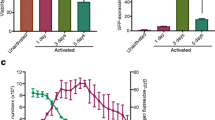Abstract
Many gene delivery methods have been used to transduce or transfect bone marrow-derived dendritic cells (BMDCs) for genetic engineered DC vaccine research. The present study, for the first time, evaluated the efficiencies of four methods (lipofection, DNA electroporation, recombinant adeno-associated virus type 2 (rAAV2) transduction, and recombinant lentivirus (rLV) transduction) using EGFP as a report gene in the same BMDC culture system. Our data demonstrate that rLV transduction is the most effective method; both lipofection and DNA electroporation transfect BMDCs at lower efficiencies; rAAV2 can hardly transduce BMDCs. Furthermore, our results, for the first time, demonstrate that rLV transduction efficiency on BMDCs can be improved significantly by co-centrifugation and repeated transduction.







Similar content being viewed by others
Abbreviations
- BMDC:
-
Bone marrow-derived dendritic cell
- GM-CSF:
-
Granulocyte–macrophage colony-stimulating factor
- rLV:
-
Recombinant lentivirus
- rAAV2:
-
Recombinant adeno-associated virus type 2
- MOI:
-
Multiplicity of infection
- TU:
-
Transduction unit
- APC:
-
Antigen presenting cell
References
Yang, S. X., Vervaert, C. E., Burch, J., Jr., Grichnik, J., Seigler, H. F., & Darrow, T. L. (1999). Murine dendritic cells transfected with human GP100 elicit both antigen-specific CD8(+) and CD4(+) T-cell responses and are more effective than DNA vaccines at generating anti-tumor immunity. International Journal of Cancer, 83, 532–540.
Ke, S., Chen, X. H., Li, H., Li, J. F., Gu, Q. L., Zhu, Z. G., et al. (2006). Optimization of electroporation parameters for transfection of plasmid DNA into mature bone marrow derived dendritic cell. Journal of Shanghai Second Medical University, 18, 71–76.
Zhang, Y., Chirmule, N., Gao, G. P., & Wilson, J. M. (2000). CD40 ligand dependent activation of cytotoxic T lymphocytes by adeno-associated virus vectors in vivo: Role of immature dendritic cells. Journal of Virology, 74, 8003–8010.
Breckpot, K., Dullaers, M., Bonehill, A., van Meirvenne, S., Heirman, C., de Greef, C., et al. (2003). Lentivirally transduced dendritic cells as a tool for cancer immunotherapy. Journal of Gene Medicine, 5, 654–667.
Rouas, R., Uch, R., Cleuter, Y., Jordier, F., Bagnis, C., Mannoni, P., et al. (2002). Lentiviral-mediated gene delivery in human monocyte-derived dendritic cells: Optimized design and procedures for highly efficient transduction compatible with clinical constraints. Cancer Gene Therapy, 9, 715–724.
Lutz, M. B., Kukutsch, N., Ogilvie, A. L. J., Rössner, S., Koch, F., Romani, N., et al. (1999). An advanced culture method for generating large quantities of highly pure dendritic cells from mouse bone marrow. Journal of Immunological Methods, 223, 77–92.
Auricchio, A., Hildinger, M., O’Connor, E., Gao, G. P., & Wilson, J. M. (2001). Isolation of highly infectious and pure adeno-associated virus type 2 vectors with a single-step gravity-flow column. Human Gene Therapy, 12, 71–76.
Naldini, L., Blömer, U., Gallay, P., Ory, D., Mulligan, R., Gage, F. H., et al. (1996). In vivo gene delivery and stable transduction of nondividing cells by a lentiviral vector. Science, 272, 263–267.
Van Meirvenne, S., Straetman, L., Heirman, C., Dullaers, M., De Greef, C., Van Tendeloo, V., et al. (2002). Efficient genetic modification of murine dendritic cells by electroporation with mRNA. Cancer Gene Therapy, 9, 787–797.
Bartlett, J. S., Wilcher, R., & Jude Samulski, R. (2000). Infectious entry pathway of adeno-associated virus and adeno-associated virus vectors. Journal of Virology, 74, 2777–2785.
Liang, C. M., Ye, S. L., Zhong, C. P., Zheng, N., Bian, W., Sun, R. X., et al. (2007). More than chemotaxis: A new anti-tumor DC vaccine modified by rAAV2-SLC. Molecular Immunology, 44, 3797–3804.
He, Y. K., Zhang, J. Y., Mi, Z. B., Robbins, P., & Falo, L. D. Jr. (2005). Immunization with lentiviral vector-transduced dendritic cells induces strong and long-lasting T cell responses and therapeutic immunity. Journal of Immunology, 174, 3808–3817.
Firat, H., Zennou, V., Garcia-Pons, F., Ginhoux, F., Madeleine, C., Danos, O., et al. (2002). Use of a lentiviral flap vector for induction of CTL immunity against melanoma. Perspectives for immunotherapy. Journal of Gene Medicine, 4, 38–45.
Acknowledgment
This study was supported by The Hi-Tech Research and Development of China, Grant No. 2006AA02A102.
Author information
Authors and Affiliations
Corresponding author
Rights and permissions
About this article
Cite this article
Li, GB., Lu, GX. Gene Delivery Efficiency in Bone Marrow-derived Dendritic Cells: Comparison of Four Methods and Optimization for Lentivirus Transduction. Mol Biotechnol 43, 250–256 (2009). https://doi.org/10.1007/s12033-009-9197-1
Received:
Accepted:
Published:
Issue Date:
DOI: https://doi.org/10.1007/s12033-009-9197-1




